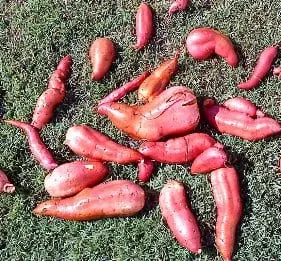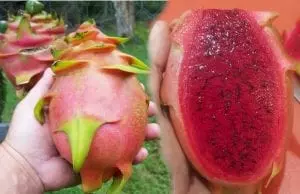Sweet potato has become quite trendy lately. I've seen this easy to grow vegetable featuring in magazines, on TV in cooking shows (and advertisements). Many Pacific Island countries rely on sweet potato as a staple food source. This oblong tuber is a good source of vitamin A (one of the best) and is high in dietary fibre with versatility for cooking and medium term storage.
One of my loathed commercials on TV at the moment (from a large frozen food seller) is this 40 something guy who picks up a sweet potato chip off the table at dinner and says to his tee nage daughter, “what's this?” She replies, “that's a sweet potato chip!” So he takes a bite and gives a gratifying nod of approval “mmm,” he goes. What a dummy, a chip's a chip mate; lucky he had the “Y” generation there to help him! Naturally, the undertone of the commercial is not to show how stupid men are; rather to depict how not many of us know what a sweet potato is, therefore, they want us to try one of these “alien foods” and we'll be so smitten with their new cryogenic product of discovery that we'll continue to buy it. Which is complete garbage of course, we all know what sweet potato is…right?
nage daughter, “what's this?” She replies, “that's a sweet potato chip!” So he takes a bite and gives a gratifying nod of approval “mmm,” he goes. What a dummy, a chip's a chip mate; lucky he had the “Y” generation there to help him! Naturally, the undertone of the commercial is not to show how stupid men are; rather to depict how not many of us know what a sweet potato is, therefore, they want us to try one of these “alien foods” and we'll be so smitten with their new cryogenic product of discovery that we'll continue to buy it. Which is complete garbage of course, we all know what sweet potato is…right?
Well, most of us probably know what one looks like and here are some facts to go with the visual:
-
Sweet potatoes belong in the root group of vegetables (those veggies with edible roots or tubers mostly below ground – like carrots);
-
Ideally, a mature tuber is about 8 inches long and 4 inches wide (they can get much bigger but the bigger ones tend to get more “woody” – still edible). The small ones are delicious peeled and roasted whole.
-
There are several common varieties to grow but usually they either have a white or orange flesh with a purple or orange skin – both taste terrific!
-
Also, the leaves of the sweet potato plant can be cooked and eaten (like spinach); and
-
The above ground plant is a vine (unlike potatoes) and it loves to climb or sprawl along the ground.
-
The vine gets sprinkled with pretty pink trumpet-like flowers in late spring or early summer so it can be quite ornamental too.
 Growing Sweet Potato
Growing Sweet Potato
Sweet potato is easy to grow. Under the right conditions the plant can even get out of control and require some fair maintenance (like regular pruning). It's a perennial plant but many people grow sweet potato as an annual due to its frost sensitivity particularly if you live in a temperate or a cold climate. Personally, I have a dedicated sweet potato trellis, which I have grown my sweet potato on for several years now, all year-round. I don't dig-up and re-plant the tubers seasonally because I have found by leaving the vine growing through winter it does suffer a little but once spring hits she's off and sprawling and the tubers still remaining in the ground re-shoot and grow new plants.
However, I do live in the subtropics where the winters here are reasonably mild. Temperatures can drop below 5ºC but rarely does it frost so I can leave the vine grow its heart out through summer give it a prune and then just leave it through winter. Some other points about growing sweet potato are:
-
Like I alluded, it prefers a tropical climate but will grow anywhere with the right care. In a cool climate either grow it in a green house or plant tubers after frosts are over and grow as an annual through summer then dig-up keeping some tubers in storage through winter.
-
Does like a crumbly or sandy soil but it will grow in heavier soils as long as compost and organic matter are dug in. Tubers may force to the surface if the soil is too heavy – in this case harvest the tubers or rodents may have a gnaw on the exposed areas.
-
Enjoys fertile soil so dig-in some manure or a few handfuls of blood and bone thrown around prior to planting helps. Feed with a soluble fertiliser high in nitrogen occasionally throughout the growing season and this should keep it happy.
-
Full sun is best; however, good results can be attained in semi-shade.
-
Give plenty of water for best development (tropical plant). Having said that, I've seen the plant survive long dry spells.
-
Grown on a trellis is the easiest way to control the plant.
-
Tubers develop over a few months or all year-round depending on location and lightly digging in the soil around the base of the plant to check the size doesn't hurt. You'll find the tubers just under the surface to about 12 inches down.
-
Harvesting some tubers throughout growing is fine – the plant may die-off in some areas but it should continue to grow well. I use a strong garden fork to dig down and lift the tubers; occasionally, I spear one through the middle so I eat it first.
-
At the end of the season (for cool regions) dig-up the remainder of your harvest and remember to keep a few for next season in a dark place or in some sand.
-
In spring, the tubers will start to shoot again and you can either divide them into chunks and plant them out just under the soil surface or remove shoots as cuttings for potting-up or planting. If you ate them all you can buy seedlings easily enough or just buy a tuber from the markets.
-
If you're going to make a semi-permanent trellis then “refresh” the garden bed each year with a light dig adding compost and manure.
-
Makes a great substitute for potatoes, as potatoes are difficult to grow in tropical or subtropical climates.
Disease and Pests
Not much goes wrong with the sweet potato plant and I've never had a pest problem with mine; still, it can get attacked (like most plants) by aphids, mites, whitefly or the odd grasshopper. If you find these pests in large numbers I would check the health of the plant first and see if it needs some food and you can usually tell if a plant is sick or malnourished by yellowing leaves and the plant is sparse (not flourishing) – then give it a good feed. If you can't control the infestation by hand removal then try organic sprays or pyrethrum (which is naturally derived and effective).
There is also a weevil mainly in tropical locations that can attack the tubers; crop rotation may help with this little fella.
As far as diseases go, sweet potato is a robust plant – I see some rust on the leaves of mine sometimes but I generally don't do anything about it.
Frying sweet potato is probably the worst way to cook it for health reasons (fat content) although they do taste rather nice fried (with a sprinkling of chilli salt). For a snack bowl at a party, I like to cut them fine, even finer than French fries, and either dry them in my food dryer or deep fry them. The fried (julienned) sweet potato fries can also be used as a garnish, in stir-fry, or as a crunchy side in many dishes. School lunches are also a winner (just a small portion if fried) but the dried stuff is a very healthy snack for children. Just be aware dried sweet potato won't stay crunchy for weeks in the pantry as it tends to absorb moisture from the air and loses its snap so I would use it within a week of making.
Another healthy way to make sweet potato chips is to bake them either dry or lightly coated in olive oil. Baking largish pieces or small whole ones (like you would sometimes do with pumpkin) is awesome and they can also be pureed and made into soup. Furthermore, sweet potato cooks fast when boiled and makes a great mash with a little butter and cream mixed in.
You can now get these steam fryers. The concept sounds brilliant but it's beyond me how the food could come out crispy. Phillips has just introduced their latest steam fryer – I have no idea if it's any good, but if you have a one of the new Philips steam fryers (or any steam fryer for that matter) please let us know what it's like in the comments section below – I might get one if they work well.
Here's a light Asian soup recipe I make for the family regularly. I just use:
-
a good broth (I like using home-made beef stock but the store stock is fine);
-
freshly and finely chopped chilli (spice/heat to taste – I use medium) mixed in a small dish with a tspn white wine vinegar, tspn canola oil, and pinch of salt;
-
some chopped spring onion; and
-
julienned sweet potato match-stick high or less – about a cup (raw).
Method
-
Place the julienned sweet potato in the broth and bring to the boil.
-
Take straight off the heat (you don't want to overcook the potato).
-
Stir and ladle into small bowls ensuring each bowl has some sweet potato.
-
Sprinkle with some chopped spring onion.
-
Serve with the chilli mixture and a small spoon so diners can choose to put some chilli mixture (usually a teaspoon full) into their soup prior to eating. I find the chilli mix “lifts” the soup nicely.
Sorry I don't have a picture of the soup/broth but it's pretty simple to visualise.
Conclusion
And that's sweet potato! Easy to grow, nothing new, no secret, or special discovery from frozen foods land – just good old sweet potato that's been around since humans could eat.
So if you don't have sweet potato in your garden find a spot and get it growing because you and your family will love this versatile plant, which not only is a great vegetable to eat many different ways but it looks good growing in the garden too.
Thanks for reading and if you have any hints, tips, or questions about growing sweet potato please leave a comment below (no email required).
Look, and see the Earth through her eyes.
Mark Valencia – Editor SSM













